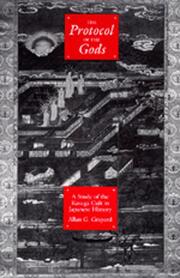| Listing 1 - 3 of 3 |
Sort by
|
Book
ISBN: 9780939512478 0939512475 Year: 1992 Publisher: Ann Arbor Center for Japanese Studies, University of Michigan
Abstract | Keywords | Export | Availability | Bookmark
 Loading...
Loading...Choose an application
- Reference Manager
- EndNote
- RefWorks (Direct export to RefWorks)
Kasuga Jinja (Nara-shi, Japan) in art --- Shinto --- Buddhism --- Relations --- Kasuga Jinja (Nara-shi, Japan)
Book
ISBN: 0231069588 9780231069588 Year: 1990 Volume: 98 Publisher: New York (N.Y.) Columbia university press
Abstract | Keywords | Export | Availability | Bookmark
 Loading...
Loading...Choose an application
- Reference Manager
- EndNote
- RefWorks (Direct export to RefWorks)
Kasuga Gongen genki --- Legends, Shinto --- Legends, Buddhist --- Japanese literature --- History and criticism. --- Kasuga Jinja (Nara-shi) dans la littérature --- Légende shintoïste --- Légende bouddhique --- Littérature --- Histoire et critique --- Japon --- -Kasuga Jinja (Nara-shi, Japan) in literature --- -Legends, Shinto --- Legends --- History and criticism --- -J1945.47 --- J1946 --- Japan: Religion -- Shintō -- shrines and pilgrimage -- Nara prefecture -- Nara city --- Japan: Religion -- Shintō -- kami --- J1912.90 --- -J1918.47 --- Japan: Religion -- Shintō -- shrines and pilgrimage -- Kansai and Kinki region -- Nara city --- Buddhist legends --- Shinto legends --- J1918.47 --- Kasuga Jinja (Nara-shi, Japan) --- Kasuga Jinja. --- Nara-shi (Japan). --- Kasuga Shrine (Nara-shi, Japan) --- Kasuga Gongen (Nara-shi, Japan) --- Kasuga no Yashiro (Nara-shi, Japan) --- Kasugasha (Nara-shi, Japan) --- 春日神社 (Nara-shi, Japan) --- Kasuga Taisha (Nara-shi, Japan) --- In literature. --- Kasuga Gongen genki. --- Legends [Shinto ] --- Legends [Buddhist ] --- Japan --- Legends, Shinto - History and criticism. --- Legends, Buddhist - Japan - History and criticism. --- Japanese literature - 1185-1600 - History and criticism.

ISBN: 0520910362 0585130590 9780520910362 9780585130590 0520070976 Year: 1992 Publisher: Berkeley University of California Press
Abstract | Keywords | Export | Availability | Bookmark
 Loading...
Loading...Choose an application
- Reference Manager
- EndNote
- RefWorks (Direct export to RefWorks)
The Protocol of the Gods is a pioneering study of the history of relations between Japanese native institutions (Shinto shrines) and imported Buddhist institutions (Buddhist temples). Using the Kasuga Shinto shrine and the Kofukuji Buddhist temple, one of the oldest and largest of the shrine-temple complexes, Allan Grapard characterizes what he calls the combinatory character of pre-modern Japanese religiosity. He argues that Shintoism and Buddhism should not be studied in isolation, as hitherto supposed. Rather, a study of the individual and shared characteristics of their respective origins, evolutions, structures, and practices can serve as a model for understanding the pre-modern Japanese religious experience. Spanning the years from a period before historical records to the forcible separation of the Kasuga-Kofukuji complex by the Meiji government in 1868, Grapard presents a wealth of little-known material. He includes translations of rare texts and provides new, accessible translations of familiar documents.
Shinto --- Buddhism --- Religion --- Philosophy & Religion --- Eastern Religions --- Religions --- Relations --- Buddhism. --- Shinto. --- Kasuga Taisha (Nara-shi, Japan) --- Kōfukuji (Nara-shi, Japan) --- Kōfukuji, Nara, Japan --- 興福寺 (Nara-shi, Japan) --- Kasuga Jinja (Nara-shi, Japan) --- Nara-shi (Japan). --- 春日大社 (Nara-shi, Japan) --- History. --- J1861 --- J1913.80 --- J1917.10 --- J1918.47 --- Buddha and Buddhism --- Lamaism --- Ris-med (Lamaism) --- Relations&delete& --- Japan: Religion -- Buddhism -- relation with Shintō (and Shinbutsu) --- Japan: Religion -- Shintō -- sects and schools -- traditional -- local, hereditary Shintō --- Japan: Religion -- Shintō -- relations -- Buddhism --- Japan: Religion -- Shintō -- shrines and pilgrimage -- Kansai and Kinki region -- Nara city --- Kōfukuji (Nara-shi, Japan) --- buddhism. --- buddhist temples. --- comparative religious studies. --- japan. --- japanese history. --- japanese religious history. --- kamakura period. --- kami. --- kasuga cult. --- kasuga gongen genki e. --- kasuga shrine. --- kofukuji kasuga multiplex. --- kofukuji temple. --- major world religions. --- meiji government. --- painted handscrolls. --- place of worship. --- polytheistic belief system. --- pre modern japanese religion. --- religion. --- religious rituals. --- shinto shrines. --- shintoism. --- shrine temple complexes. --- siddhartha gautama. --- the buddha. --- worship.
| Listing 1 - 3 of 3 |
Sort by
|

 Search
Search Feedback
Feedback About UniCat
About UniCat  Help
Help News
News